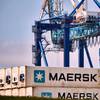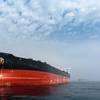In the first half of 2004, 177 million tonnes of cargo was transhipped in the port of Rotterdam, 8 percent more than the first half of 2003. Outgoing trade increased more noticeably than incoming trade (6.7% and 11.6% respectively) and general cargo grew almost twice as fast (12%) as bulk cargo. Only the amount of coal handled was down (2%) on the first half of last year. The other categories of goods grew: agribulk (+10.6%), ores and scrap (+7.6%), other dry bulk (+6.6%), crude oil (+5.3%), mineral oil products (+13.2%), other liquid bulk (+5.6%), roro (+5.5%), containers (+13.3%) and other general cargo (+7.8%). In numbers, container throughput increased by 12% to 4 million TEU (20-foot units). The prospects for throughput in the second half of the year are good.
Willem Scholten, Port of Rotterdam CEO: "Eight percent more throughput is unique. Such across-the-board growth has seldom happened before, if ever. The rise of China, in itself and as a catalyst for developments elsewhere, is playing an important role. The broad distribution points to more than this, however. In the past couple of years, investment has been heavier in the port than anywhere else in the Netherlands. And now it's payback time. Investment pays".
Dry bulk
The total quantity of dry bulk increased by 5% to 45 million tonnes. The upward movement in agribulk (grains, seeds, raw materials for animal feed) throughput that started last year is continuing: +11% to 5.4 million tonnes. This is due to the incoming trade in derivatives and tapioca for the mixed feed industry. Soya bean imports and grain exports fell. In the second half of the year, imports of tapioca will decline, so that annual results will probably be a little below the 2003 level.
About 250,000 tonnes less coal was handled. A few ships had to divert to other ports due to capacity problems. In addition, it is a tight squeeze for the very large ships, "capesizers", and the smaller "panamaxes" are more often used. These can also be accommodated in rival ports. Due to start-up problems, the new EECV terminal was unable to compensate adequately. Throughput was down 2% to 11 million tonnes. In the second half of the year things are expected to improve again as a result of the increase in German imports and the return to service of the Amercentrale's coal unit and the coal unloader at EECV.
Throughput figures for ores and scrap were almost 8% up, to 23 million tonnes. In the EU25, steel production increased by 3.5%. Demand is primarily from China, where there is also a great hunger for scrap. A significant negative indicator for the rest of the year, however, is the decline in German production of pig iron by 1.4%. Yet we can reasonably expect a slight increase in ore throughput for the year as a whole. Other dry bulk grew by 7% in comparison with the already excellent first half of 2003 (+15%), to 5.5 million tonnes. With production in the steel and chemical industry picking up, imports of minerals are also increasing further. Huge quantities of minerals arrive by "parcel service" from China and South Africa.
Liquid bulk
The total rose by 7% to 82 million tonnes. Incoming trade in crude oil experienced one of the best six-month periods in years, with an increase of 5% to 53 million tonnes. As in 2003, the refinery sector is doing good business: demand is high and margins are considerable. As no stops for maintenance work have been planned this year, annual throughput is expected to be 5 million tonnes higher.
Imports of oil products remained stable at 10 million tonnes, but exports rose significantly by almost 40% to 7 million tonnes. This can be attributed mainly to the transit trade in Russian fuel oil. Last spring, six VLCCs, each with a deadweight capacity in the region of 250,000 tonnes, set off with fuel oil destined for the Far East. For the lighter products, particularly petrol, the United States is the main destination.
The transhipment of other liquid bulk, mostly basic chemicals, was 6% up to 13 million tonnes. This is slightly higher than in the top years (for chemicals) 2000 and 2001, but results have actually been extremely good for the past five years. The Dutch Chemical Industry Federation expects a 4% growth in volume this year. This being the case, it is feasible that 26 million tonnes of liquid bulk could be handled.
General cargo
This sector had an extremely good first six months, with an increase of 5 million tonnes (+12%) to 50 million tonnes. In containers, imports were up by 13%, from 35 to 40 million tonnes. Both incoming and outgoing trade rose by about 13%. In numbers, this was in the region of 12%, to 4 million TEU (+500,000). The Far East is the motor behind the increase in container throughput. This is already creating a shortage of capacity at virtually every large terminal in Western Europe. ECT showed 20% growth - three times the expected rate - prompting it to take on extra staff and move forward investments. In the second half of the year, total growth could increase due to the more intensive use of a number of deepsea terminals. Roll-on/roll-off increased by 5.5% to 5.5 million tonnes. A little more than half of this is outgoing trade. The increase is the result of the growth in trade between the UK and the continent. Cobelfret Ferries responded to this by increasing capacity to Purfleet. DFDS Tor Line decided to incorporate two calls in Rotterdam a week into its service between England and Sweden. Also related to England is the increase in the transhipment of cars: at the beginning of this year, Mazda entered into a contract with RCC/RCT for transit trade to Great Britain.
Due to a small 8% leap to 4.5 million tonnes, other general cargo returned to its 2000 level. New in 2004 were the "all weather terminals" from Gevelco (steel from Sweden and paper from Portugal) and DFDS Tor Line (new in paper, from Norway). These terminals will have a greater impact on the results in the second half of the year. In the first six months, LASH shipping (a lot of steel going out, paper, rice) to/from the United States and incoming trade in fruit and vegetables (+20%) from South Africa and South America also did well.
Subscribe for
Maritime Reporter E-News
Maritime Reporter E-News is the maritime industry's largest circulation and most authoritative ENews Service, delivered to your Email five times per week










